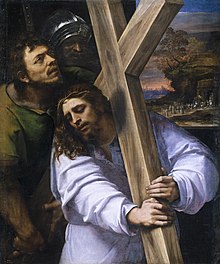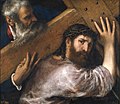Christ Carrying the Cross

Christ Carrying the Cross on his way to
Biblical references

The carrying of the cross is mentioned, without much detail, in all the canonical
Only Luke mentions the "women of Jerusalem", who were in later patristic writings and Christian art taken to include the
Also of relevance is Matthew 16:24, with which St Francis of Assisi began his first Rule of 1221: "Then Jesus said to his disciples, “Whoever wants to be my disciple must deny themselves and take up their cross and follow me". St Francis also used to be led with a cord around his neck as a penitential exercise, the cord being a detail added to many depictions of the episode from two Old Testament passages. These are Isaiah 53:7: "He was oppressed and afflicted, yet he did not open his mouth; he was led like a lamb to the slaughter, and as a sheep before its shearers is silent, so he did not open his mouth" and Jeremiah 11:19 "I had been like a gentle lamb led to the slaughter...", both of which were very frequently cited by medieval commentaries.[6] In medieval typology, Isaac carrying wood up the mountain for his sacrifice is the most common parallel for the episode, and often shown as a complementary scene; this scene is "Isaac Bearing the Faggots" (or "wood") in traditional art history terminology.[7]
In popular devotions
The fully elaborated traditional account of the episode is demonstrated in the Stations of the Cross, where it is divided into a number of incidents, which between them account for most sculptural depictions:[8]
- Pilate sentences Christ
- Jesus is given His cross
- Jesus falls the first time
- Jesus meets His Mother
- Simon of Cyrene carries the cross
- Veronica wipes the face of Jesus
- Jesus falls the second time
- Jesus meets the daughters of Jerusalem
- Jesus falls the third time
Ten through fourteen cover the rest of the Passion.
It is also one of the Sorrowful Mysteries of the
History of the depiction
Until around 1100, Simon of Cyrene was more often shown actually carrying the cross than Jesus, and from this time the number of other figures typically included in the scene increases. In Byzantine depictions, Jesus typically walks with his hands bound, and a soldier leading him holding the rope, as Simon carries the cross. In some early depictions, Jesus and Simon carry the cross together. In the later Middle Ages, probably influenced by

An early example of a type of devotional image showing Jesus alone is a small panel by
From around 1500, the subject became used for single piece altarpieces in Italy, usually showing either the meeting with Veronica or the Swoon of the Virgin or spasimo, when the Virgin swoons, faints, or at least falls to her knees, both fairly recent and rather controversial introductions, without scriptural authority.[13]
Works
Individual works with articles include the following (apart from a large number of cycles featuring the scene):
- Christ Falling on the Way to Calvary (Raphael), or Lo Spasimo
- Christ Carrying the Cross (Titian)
- Cristo della Minerva, sculpture by Michelangelo
- Christ Carrying the Cross (Bosch, Ghent)
- Christ Carrying the Cross (Bosch, Madrid)
- Christ Carrying the Cross (Bosch, Vienna)
- Christ Carrying the Cross (El Greco, Barcelona)
- Christ Carrying the Cross (El Greco, Madrid)
- Christ Carrying the Cross (El Greco, New York)
- Procession to Calvary, painting by Pieter Bruegel the Elder
Gallery
-
Christ, with aDominican friar, Barna da Siena, 1330–1350
-
Sandro Botticelli, 1490–91
-
Jesus Christ bearing the Cross, Lorch in the Rhine Valley, ca. 1425,Bodemuseum Berlin
-
Titian, c. 1565
-
El Greco, c. 1602
Notes
- ^ Schiller, 78-82
- ^ Andreas J. Köstenberger John 2004 Page 598 "... the patibulum (see commentary at 19:17) and compelled to carry his cross to the place of execution.13 Hence, ... Dionysius of Halicarnassus, Antiquitates romanae 7.69; Tertullian, De pudicitia 22 (cited in Köstenberger 2002c: 194).
- ^ Schiller, 78–81
- ^ Zuffi, 283; See Schiller 81 for later exceptions, including one by Tintoretto
- ^ Penny, 8
- ^ Sawyer, 89; Israels, 423
- ^ Schiller, 80, 82
- ^ Schiller, 82
- ^ Schiller, 81
- ^ Schiller, 80-81
- ^ Brown etc., 102-103, 110-111
- ^ Penny, 8-10
References
- Brown, David Alan, Pagden, Sylvia Ferino, Anderson, Jaynie eds., Bellini, Giorgione, Titian, and the Renaissance of Venetian painting (exhibition at the National Gallery of Art (Washington) and Kunsthistorisches Museum Wien, Yale University Press, 2006,
- Israėls, Machtelt, Sassetta: the Borgo San Sepolcro altarpiece, Volume 1, 2009, Harvard University Press,
- ISBN 1-85709-913-3
- Sawyer, John F. A., The fifth gospel: Isaiah in the history of Christianity, 1996, Cambridge University Press, 1996,
- ISBN 0-85331-324-5
- Zuffi, Stefano, Gospel figures in art, a Guide to imagery, Getty Publications, 2003, ISBN 0-89236-727-X, 9780892367276, Google books





